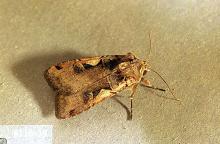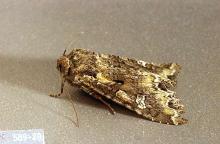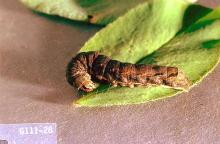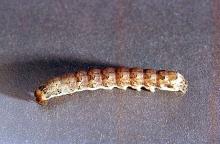Includes
Bertha armyworm (Mamestra configurata)
Spotted cutworm (Xestia spp.)
Variegated cutworm (Peridroma saucia)
Winter cutworm (Noctua pronuba)
Pest description and crop damage Several species of armyworm and cutworm attack tree fruits (see also: Lacanobia fruitworm). The most common species found in tree fruit in the PNW are the bertha armyworm and the spotted cutworm. Winter cutworm is a relatively new cold-tolerant species that may at times occur in orchards (see EM9139, http://catalog.extension.oregonstate.edu/sites/catalog/files/project/pdf/em9139.pdf). Adults are large moths ranging in color from gray to brown with spots on the wings. The adult moths are attracted to lights. Larvae are dirty white, reddish, gray or black caterpillars up to 2 inches in length. Larvae of these moths feed on buds and leaves, chewing holes in buds and ragged holes out of leaves. They also feed on the growing tips, particularly on small trees or in high density plantings. On larger trees, most of the feeding is on the lower branches, and may be concentrated to a few stems or limbs, while other stems are undamaged.
Biology and life history Weeds are the preferred source of food for these larvae, and eggs typically are laid on weeds around the trees. Eggs are laid in large clusters. Depending on species, they may overwinter as pupae or larvae in the soil. The larvae spend the day in the soil, and then climb up the tree during the night to feed, often following the same path.
Management-cultural control
Control weeds, grasses, and debris in the orchard that provide cover. Natural enemies of cutworms include birds and spiders. Hand-pick cutworm larvae, using a flashlight to find them, if practical. Scratch the soil at the base of plants to find larvae in the daytime. Caterpillars can be trapped by tying plastic wrap tightly around branches and trunks, then applying Tanglefoot or a similar sticky material to the plastic wrap. Remove these in the fall.
Management-chemical control: HOME USE
Spring and summer
- acetamiprid
- azadirachtin (neem oil)-Some formulations are OMRI-listed for organic use.
- Bacillus thuringiensis var. kurstaki (Btk)-Some formulations are OMRI-listed for organic use
- carbaryl-Highly toxic to bees.
- gamma-cyhalothrin-Highly toxic to bees.
- insecticidal soap-Some formulations OMRI-listed for organic use.
- kaolin clay-Applied as a spray to leaves, stems, and fruit, it acts as a repellant to target pests. Some formulations are OMRI-listed for organic use.
- lambda-cyhalothrin-Highly toxic to bees.
- permethrin-Highly toxic to bees.
- pyrethrins-Highly toxic to bees. Some formulations are OMRI-listed for organic use.
- spinosad-Some formulations are OMRI-listed for organic use.
- zeta-cypermethrin-Highly toxic to bees.
Management-chemical control: COMMERCIAL USE
Stages 3-4: Prepink & tight cluster sprays
- Bacillus thuringiensis var. kurstaki (Btk) (Dipel DF, Javelin, etc.)-Formulations vary; see label for rates. Apply Btk materials two to three times, beginning at prepink, repeating at pink and petal fall. Apply Btk only when temperature exceeds 60°F. REI 4 hr. Some formulations are OMRI-listed for organic use. [Group 11] [larvicide]
- indoxacarb (Avaunt) at 5 to 6 oz/A in up 100 gal water per application. Make no more than three applications prior to hand-thinning. No hand thinning after the fourth application. Make no more than four applications per growing season. Do not apply more than 24 oz/A per growing season. REI 12 hr. [Group 22]
- peptide GS-omega/kappa-Hxtx-Hv1a (Spear-Lep) at 1 to 2 pints/A. Biological insecticide that should be tank mixed with equal parts of Bt. PHI 0 day. REI 4 hr.
Spring and summer
- acetamiprid (Assail 70WP) at 3.4 oz/A in up to 100 gal water per application. Do not make more than four applications per year or exceed 13.5 oz/A per growing season. REI 12 hr. PHI 7 days. [Group 4A]
- Bacillus thuringiensis var. kurstaki (Btk) (Dipel DF, Javelin, etc.)-Formulations vary; see label for rates. Apply Btk only when temperature exceeds 60°F. REI 4 hr. PHI 0 days. Some formulations are OMRI-listed for organic use. [Group 11] [larvicide]
- peptide GS-omega/kappa-Hxtx-Hv1a (Spear-Lep) at 1 to 2 pints/A. Biological insecticide that should be tank mixed with equal parts of Bt. PHI 0 days. REI 4 hr.
- phosmet (Imidan 70W) at 2.1 to 5.7 lb/A in up to 100 gal water per application. REI/PHI 7 days. [Group 1B]
- spinetoram (Delegate WG) at 4.5 to 7 oz/A in up to 100 gal water per application. Do not exceed four applications or 28 oz/A per growing season. REI 4 hr. PHI 7 days. [Group 5]





